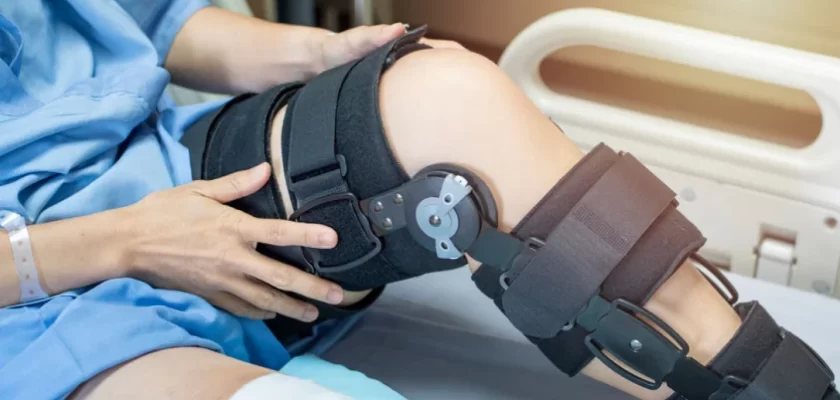The Benefits and Proper Use of a Short Knee Immobilizer
- Posted on June 24, 2023
- By Vishakha Yadav
- Read 4 minutes

A short knee immobilizer is a medical device designed to provide support and stabilization to the knee joint during the healing process. This versatile tool offers numerous benefits for patients recovering from knee injuries or surgeries. In this article, we will delve into the advantages of using a short knee immobilizer and provide valuable information on its proper use.
Understanding the Short Knee Immobilizer
A short knee immobilizer is a specialized orthopedic device that is typically made of lightweight, breathable materials such as neoprene or fabric. It is designed to restrict movement in the knee joint and provide stability and protection following an injury or surgical procedure. Unlike full-length knee braces, the short knee immobilizer focuses specifically on the knee region.
Benefits of Using a Short Knee Immobilizer
Stability and Support: A short knee immobilizer offers excellent stability and support to the knee joint, minimizing the risk of further injury or strain during the recovery process. It helps maintain proper alignment and prevents excessive movements that could impede healing.
Pain Relief: The immobilizer helps reduce pain by limiting excessive movement and providing compression around the knee, which can alleviate discomfort and promote a more comfortable healing process.
Protection: It acts as a protective barrier, guarding the knee against external impacts and potential re-injury. This is especially beneficial during physical activities or when navigating crowded environments.
Enhanced Healing: By limiting motion, the immobilizer allows the injured knee to heal more effectively, reducing the recovery time. It provides the necessary stability for the body’s natural healing processes to occur without interference.
Versatility: The short knee immobilizer is lightweight and less bulky compared to full-length braces, allowing patients to wear it discreetly and comfortably under clothing. It offers greater freedom of movement while still providing essential support.
Proper Usage of a Short Knee Immobilizer
Consultation with a Healthcare Professional
Before using a short knee immobilizer, it is crucial to consult with a healthcare professional who can evaluate your specific condition and determine if it is appropriate for your recovery process. They will provide guidance on the duration and extent of usage required based on your individual needs.
Applying the Short Knee Immobilizer
Clean the knee area thoroughly and ensure it is dry before application. This helps maintain proper hygiene and prevents skin irritation.
Place the immobilizer around the knee, ensuring a snug fit without being overly tight or restrictive. The device should provide enough compression to stabilize the knee while still allowing for comfortable movement.
Fasten the straps or closures according to the instructions provided with the immobilizer. Adjust the tension to achieve a comfortable and secure fit. Ensure that the immobilizer does not impede blood circulation or cause discomfort.
Duration of Usage
The duration of immobilizer usage varies depending on the severity of the injury or surgical procedure. It is essential to follow the guidance of your healthcare professional regarding when and for how long the immobilizer should be worn. In some cases, the immobilizer may be required only during physical activities or during specific periods of the day. Adhering to the recommended duration ensures optimal support and promotes proper healing.
Maintenance and Care
To ensure optimal functionality and hygiene, it is important to maintain and care for the short knee immobilizer properly. Follow the manufacturer’s instructions for cleaning and storing the device. Regularly inspect the immobilizer for any signs of wear or damage, and replace it if necessary. Proper maintenance prolongs the lifespan of the immobilizer and ensures it continues to provide the necessary support.
Precautions and Considerations
Individual Differences
Every patient’s condition is unique, and what works for one person may not be suitable for another. Always consult with a healthcare professional to determine if a short knee immobilizer is the right choice for your specific situation. They will consider factors such as the nature of your injury, your overall health, and any pre-existing conditions.
Allergic Reactions
Some individuals may experience skin irritation or allergic reactions to the materials used in the immobilizer. If you notice any adverse reactions, such as redness, itching, or swelling, discontinue use and consult your healthcare professional. They can recommend alternative materials or products that are better suited to your needs.
Proper Fit and Comfort
Ensure that the short knee immobilizer fits properly and offers adequate comfort. It should not be excessively tight, causing discomfort or impeding blood circulation. If you experience persistent discomfort or pain while wearing the immobilizer, consult your healthcare professional. They can assess the fit and recommend adjustments or alternative options for improved comfort.
It is an effective tool in promoting optimal recovery for individuals with knee injuries or those who have undergone knee surgery. By providing stability, support, and protection, it helps reduce pain, enhance healing, and prevent further damage. Remember to consult with a healthcare professional for personalized advice and follow their instructions on proper usage, duration, and maintenance. Utilizing a short knee immobilizer correctly can contribute significantly to a successful rehabilitation process and restore your knee’s health and functionality.
